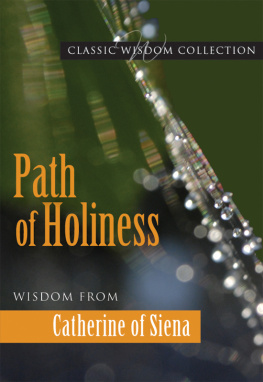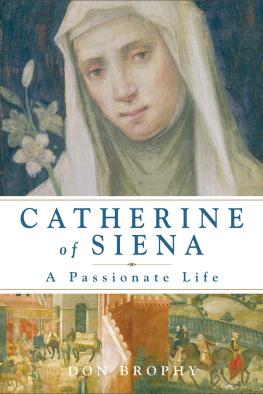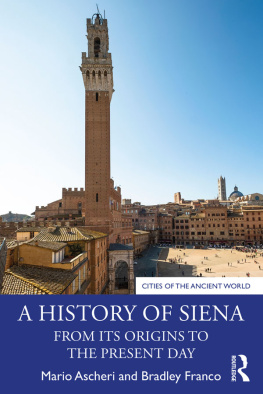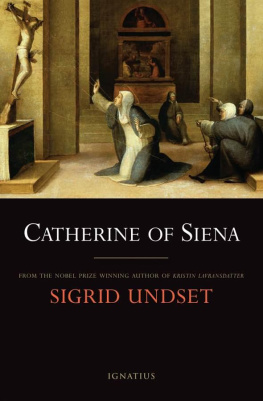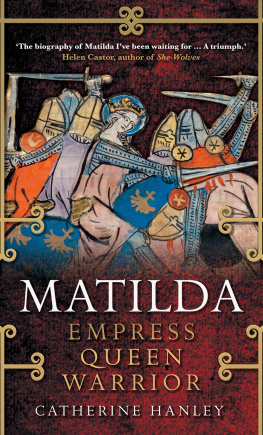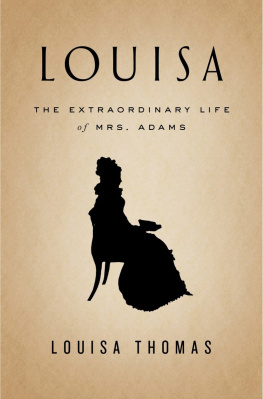THE ROAD TO SIENA
The Essential Biography of St. Catherine

St. Catherine of Siena, from an engraving
THE ROAD TO SIENA
The Essential Biography of St. Catherine
EDMUND G. GARDNER
EDITED WITH FOREWORD AND ANNOTATIONS BY
JON M. SWEENEY

The Road to Siena: The Essential Biography of St. Catherine
2009 First Printing
Copyright 2009 by Jon M. Sweeney
ISBN: 978-1-55725-621-8
Scripture quotations are taken from the New Jerusalem Bible, published and
copyright 1985 by Darton, Longman & Todd Ltd. and Doubleday, a division
of Random House Inc., and are used by permission of the publishers.
Library of Congress Cataloging-in-Publication Data
Gardner, Edmund Garratt, 1869-1935.
The road to Siena : the essential biography of St. Catherine / Edmund G. Gardner ; edited with foreword and annotations by Jon M. Sweeney.[New ed.].
p. cm.
Rev. ed. of: Saint Catherine of Siena.
Includes bibliographical references and index.
ISBN 978-1-55725-621-8
1. Catherine, of Siena, Saint, 1347-1380 I. Sweeney, Jon M., 1967- II. Gardner, Edmund Garratt, 1869-1935. Saint Catherine of Siena. III. Title.
BX4700.C4G3 2009
282.092dc22
[B]
2009012874
10 9 8 7 6 5 4 3 2 1
All rights reserved. No part of this book may be reproduced, stored in an electronic retrieval system, or transmitted in any form or by any meanselectronic, mechanical, photocopy, recording, or any otherexcept for brief quotations in printed reviews, without the prior permission of the publisher.
Published by Paraclete Press
Brewster, Massachusetts
www.paracletepress.com
Printed in the United States of America
CONTENTS
FOREWORD
Edmund Garrett Gardners classic work on St. Catherine of Siena was groundbreaking in its day, and it is still one of the most important biographies ever written of a medieval saint. It was originally published in 1907 under the title Saint Catherine of Siena: A Study in the Religion, Literature and History of the Fourteenth Century in Italy, by J. M. Dent & Co. in London, and E. P. Dutton & Co. in New York. In the bibliography published at the back of her own classic work Mysticism: A Study in the Nature and Development of Spiritual Consciousness (1911), Evelyn Underhill referred to Gardners book with the following special, short sentence:
(The best modern biography.)
In fact, it was really the only modern biography of St. Catherine. But Underhill rarely made that sort of comment about the biographies of other saints; in conversation, she was known to advise people to read Gardners Saint Catherine of Siena if they wanted to see how a biography of a saint should be written.
Edmund Gardner was the first to uncover and examine original documents related to the life of St. Catherine, left largely untouched for five centuries. Like any modern historian, he practiced textual criticism and historical criticism, and insisted on not simply retelling the legends of the saint for a new generation. As he explains in his Introduction, I have been aided greatly by the manuscripts still preserved of Catherines letters, manuscripts full of unpublished matter that has been unaccountably neglected, having apparently escaped the notice of all of her previous biographers and editors. This material throws light upon every aspect of the saints genius and has enabled me, at many points, to correct erroneously accepted ideas about the events of her life and the order of her writings.
The original editions advertisements, included by the publisher at the back of the 1907 book, included this intriguing sentence: Much of the book is based upon hitherto unpublished documents in the Secret Archives of the Vatican, and in the libraries of Rome and Florence. The way that Secret Archives is capitalized might make you think that the publishers were attempting to be salacious, but it is true that Gardner was the first historian to uncover documents relating to Catherines story, and there is indeed a room in the Vatican by that name! Today, the Vatican Secret Archives even has a website, and makes many texts available online.
But Gardners were the days when Catholicism was still seen as somewhat suspect and a bit exotic and dangerous in England, where he lived and taught his university students. Even today, the 1701 Act of Settlement, which states that any royal descendent who is Catholic or married to a Catholic is for ever excluded from the line of succession, still stands. Members of the royal family still renounce their Catholic faith, or convert to the Church of England, in order to maintain their position. This happened as recently as May 2008, when the Catholic News Agency reported: A woman engaged to a member of the British royal family has renounced her Catholic faith to maintain her fiancs position in the line of succession. The Times Online reports that Autumn Kelly, 31, was received into the Church of England. She is to be married to Peter Phillips, Queen Elizabeth IIs eldest grandson, on May 17.
Edmund Gardner was a professor of Italian at Gonville and Caius College, Cambridge. He wrote many books over a long career, including books on Dante, English mystics, the city of Florence, the city of Siena, Arthurian legends, and Italian Renaissance painters. He also wrote many articles for the Catholic Encyclopedia (now easily accessed on the Web at newadvent.org), which was at the height of its groundbreaking compilation from 190714, the years of Gardners most creative activity.
Throughout all of his books, Gardner was most fascinated by Christian mystics, and he tried to understand their unusual sort of knowledge and intuition. Nowhere is this seen more clearly than in Gardners early worka study of the third part of Dantes Divine Comedy, the Paradiso. He summarizes the theme of Dantes Paradiso thusly: the mystical union of the soul with the First Cause in vision, love and enjoyment, and the comprehension of the most sublime and secret things of the celestial mysteries.
One of Gardners most reprinted essays, which first appeared in 1913 and is titled The Science of Love, is also about the mysticism in Dantes Paradiso. Gardner begins in this way, by quoting Thomas Aquinas: Man, writes Aquinas, has three kinds of knowledge of divine things. The first of these is according as man, by the natural light of reason, ascends through creatures into the knowledge of God; the second is in so far as the divine truth, exceeding human understanding, descends to us by way of revelation, not however as though demonstrated to our sight, but as set forth in words to be believed; the third is according as the human mind is elevated to the perfect intuition of the things that are revealed. It was this third form of knowledge that most intrigued him.
It only remainsbefore turning to Gardners remarkable recounting of the life of St. Catherineto say a few words about the way in which Gardners original work has been re-edited for the present edition. It was common a century ago for biographers to describe and display all of their tools before proceeding with the actual building of the building. The original preface to Gardners masterwork does just this sort of thing, describing the dating of primary source materials, textual variances from one manuscript to another, and so on. I have removed most of this detail for two reasons. First, much of it has been superseded by subsequent scholarship over the century since it was first written. And second, because todays reader tends to have less interest in it; the reader who wants to delve into such subjects today will usually consult the scholarly journals that are read only by specialists.
Next page


